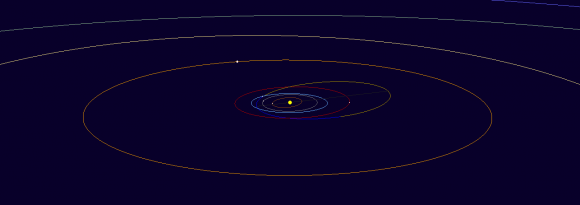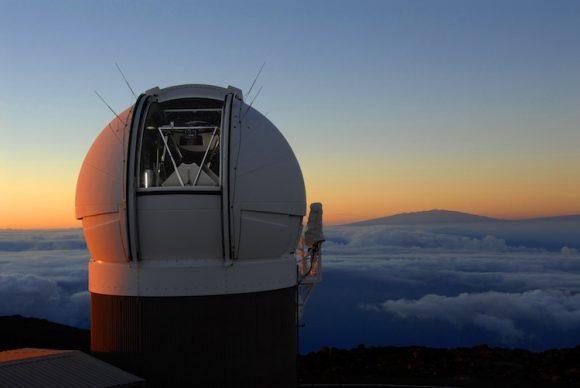Yesterday (on May 8th, 2017), an asteroid swung past Earth on its way towards the Sun. This Near Earth Object (NEO), known as 2017 HX4, measures between 10 and 33 meters (32.8 and 108 feet) and made its closest approach to Earth at 11:58 am UT (7:58 am EDT; 4:58 am PT). Naturally, there were surely those who wondered if this asteroid would hit us and trigger a terrible cataclysm!
But of course, like most NEOs that periodically make a close pass to Earth, 2017 HX4 passed us by at a very safe distance. In fact, the asteroid’s closest approach to Earth was estimated to be at a distance of 3.7 Lunar Distances (LD) – i.e. almost four times the distance between the Earth and the Moon. This, and other pertinent information was tweeted in advance by the International Astronomical Union’s Minor Planet Center (IAU MPC) on April 29th.
This object was first spotted on April 26th, 2017, using the 1.8 meter Panoramic Survey Telescope and Rapid Response System (Pan-STARRS), located at the summit of Haleakala in Hawaii. Since that time, it has been monitored by multiple telescopes around the world, and its tracking data and information about its orbit and other characteristics has been provided by the IAU MPC.

With funding provided by NASA’s Near-Earth Object Observations program, the IAU MPC maintains a centralized database that is responsible for the identification, designation and orbit computations of all the minor planets, comets and outer satellites of the Solar System. Since it’s inception, it has been maintaining information on 16,202 Near-Earth Objects, 729,626 Minor Planets, and 3,976 comets.
But it is the NEOs that are of particular interest, since they periodically make close approaches to Earth. In the case of 2017 HX4, the object has been shown to have an orbital period of 2.37 years, following a path that takes it from beyond the orbit of Venus to well beyond the orbit of Mars. In other words, it orbits our Sun at an average distance (semi-major axis) of 1.776 AU, ranging from about 0.88 AU at perihelion to 2.669 AU at aphelion.
Since it was first spotted, the object has been viewed a total of 41 times between April 26th and May 4th. In addition to the Pan-STARRS-1 survey, observations were also provided by the Cerro Tololo Observatory, the Mauna Kea Observatories, the Steward Observatory and the Kitt Peak-Spacewatch Telescopes, the Astronomical Research Observatory, the Apache Point Observatory, and the Mount John Observatory.

From these combined observations, the IAU MPC was able to compile information on the object’s orbital period, when it would cross Earth’s orbit, and just how close it would come to us in the process. So, as always, there was nothing to worry about here folks. These objects are always spotted before they cross Earth’s orbit, and their paths, periods and velocities and are known about in advance.
Even so, it’s worth noting that an object of this size was nowhere near to be large enough to cause an Extinction Level Event. In fact, the asteroid that struck Earth 65 millions year ago at the end of Cretaceous era – which created the Chicxulub Crater on the Yucatan Peninsula in Mexico and caused the extinction of the dinosaurs – was estimated to measure 10 km across.
At 10 to 33 meters (32.8 to 108 feet), this asteroid would certainly have caused considerable damage if it hit us. But the results would not exactly have been cataclysmic. Still, it might not be too soon to consider getting off this ball of rock. You know, before – as Hawking has warned – a single event is able to claim all of humanity in one fell swoop!
The MPC is currently tracking the 13 NEOs that were discovered during the month of May alone, and that’s just so far. Expect to hear more about rocks that might cross our path in the future.
Further Reading: IAU Minor Planet Center


I would say it would be a two bedroom or Mc Manson size that would burn up before hitting the ground, if it did make it through the atmosphere.
Over the oceans, it may never have been noticed.
Way cool though, to know that it was noticed.
Ken